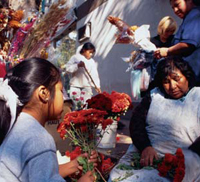From Argentina to Vietnam, students explore the world in quest for global citizenship
Life-changing. Transformative. Inspiring. These are the dramatic descriptions that often excitedly tumble forth when students return from study abroad, says Terri Givens, vice provost and associate professor of government, who oversees the university’s International Office. And for most students, the hyperbole matches reality.

“Study abroad is not just a stamp in a passport, but an unforgettable learning experience that pays dividends long after college ends,” Givens says. “It has an impact that is unique to each student, depending on their goals and interests, and I never grow tired of hearing about each student’s personal journey.”
In an era of globalization, study abroad is no longer a luxury. International experience and language skills are increasingly valuable to employers in the global economy. In response, American students are studying abroad in growing numbers. During the past decade, the number of U.S. students studying abroad each year has increased by more than 150 percent, according to the Institute for International Education’s “Open Doors” report.
—Terri Givens
The University of Texas at Austin is among the leaders of this national trend. It is ranked among the Top 3 universities sending students abroad, dispatching 2,172 students to educational programs throughout the world during the 2006-07 school year. Only New York University and Michigan State University sent more students abroad.
At the university, the College of Liberal Arts awards the most academic credit for students who complete educational programs throughout the world.
“Students graduating today realize there’s a high probability that during their career they’re going to be working with people from other cultures. It’s critical they develop cultural sensitivity if they want to be competitive in the global job market.”
Europe continues to be the primary draw for American students, with the United Kingdom, Spain, Italy and France ranked among the most popular destinations. However, students are increasingly looking beyond these perennial favorites, in part motivated by the weak American currency.
This year, China entered the Top 5 and there is an expansion in non-traditional destinations in Asia, Africa and the Middle East. Closer to home, Latin America remains a popular destination with more than 200 students selecting south-of-the-border programs in Argentina and Mexico.
Loans that Change Lives in Argentina
Imagine trying to live your life without credit cards or loans. Credit enables people to buy a car, or pay college tuition, and many people rely on credit cards to cover bills when times are tough.

But what if you didn’t have access to credit? That’s the reality for the world’s poorest citizens, explains Anjali Mohan, a senior Plan II, government and economics major who interned at Banco de la Mujer (“Women’s Bank”) in Córdoba, Argentina during the summer of 2007.
“Banco de la Mujer offered me the opportunity to help women expand their market power in Argentina, a country that is still recovering from a devastating economic crisis,” Mohan says.
As a non-profit, microfinance organization, Banco de la Mujer provides small loans to the poor without requiring collateral. Loans typically range from $50 to $250 and are payable in three to six months. The majority of borrowers are women who use the funds for small businesses and to improve their family’s standard of living.
Mohan learned about the entire microfinance process, from evaluating loan applicants to establishing repayment schedules and appraising businesses’ viability. She also traveled to rural areas with the bank’s credit officers to meet one-on-one with some of the entrepreneurs.
